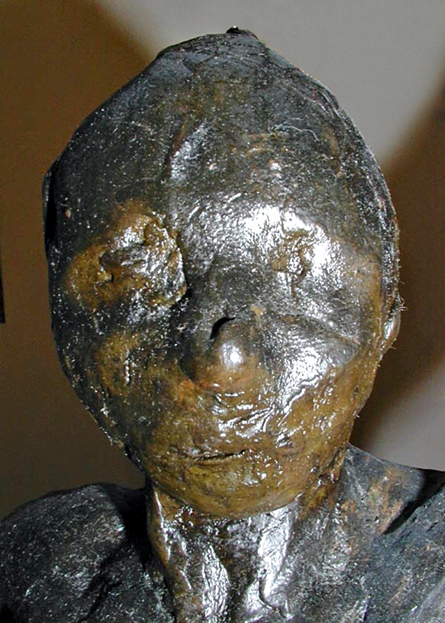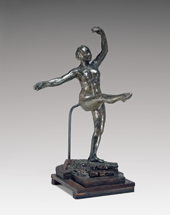The present title’s history and relation to ballet technique are identical to those for the close variant of the same title (cat. 27). Though similar to cat. 27 in pose and scale, this figure is formally distinct. The thumb is carefully distinguished from the palm and fingers, suggesting the importance of the hands to the pose. The rounded left arm en haut is higher than the arm in cat. 27 and, as Sturman observes in the Technical Notes, the right leg is longer. Its physiognomic difference may reflect a different life model. Even shapelier than the dancer in cat. 27, especially in the neck, shoulders, and arms, this muscular figure is more rounded and delicate, especially in its small, domed ovoid head, with tipped nose, eye sockets, and high, rounded forehead (see fig. 1).
This variant’s features flow so seamlessly that they seem carved or formed with molten wax (an eerie effect with the masklike color variation that Sturman describes) rather than finger-modeled. The mottled, opaque, olive-toned wax of this variant departs from cat. 27’s warm brown. The varied, extensive tooling on this one’s back and legs, which may include later campaigns to cover repairs, adds a precise linear texture to the viscous, organic quality of the modeled wax.
Suggesting the figure stood at this angle at Degas’s death, the bronzes record its obvious cant backward and to the right, on a bent, bow-legged support leg, perhaps the consequence of an armature that cannot support the weight.
With its more delicate internal structure and formal affinities with various dancers in precariously balanced poses, including cat. 27 in the same position, this figure might be dated, with them, to the mid- to late 1880s. The sequence among the three variants on this pose that Sturman proposes in the Technical Notes, on technical grounds, has strong merit.
Casts of this figure can be found in all sets of bronzes in museum collections, along with five individual casts.[1]

